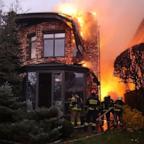'We believe that the strikes were successful': Kirby
The Department of Defense is in the early stages of battle damage assessment "but we believe that the strikes were successful," National Security Council spokesperson John Kirby told reporters in a call Friday.
"The initial indications are that we hit exactly what we meant to hit, with a number of secondary explosions associated with the ammunition and logistics locations," Lt. Gen. Douglas Sims, the director of the Joint Chiefs, said on the call.
Kirby said the strikes took place in the course of 30 minutes and involved over 125 precision-guided munitions. Of the seven total strike locations, three were in Iraq and four were in Syria, according to Sims.
Targeted facilities included command and control centers, intelligence centers, rocket missile and drone storage facilities, and logistics ammunition supply chain facilities, Kirby said.
Kirby noted the targets were chosen to avoid civilian casualties and because they were connected to enabling the attacks against the U.S. service members.
The administration does not know at this time if or how many militants may have been killed or wounded.
Officials would not tell ABC News Chief White House Correspondent Mary Bruce definitively whether there will be more strikes Friday night but said all U.S. aircraft were out of harm's way.
Kirby said the strikes are expected to continue in the "coming days."
-ABC News' Fritz Farrow, Sarah Kolinovsky and Molly Nagle





